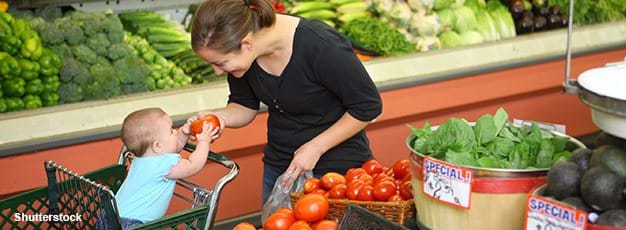Buying Power of WIC Fruit and Vegetable Voucher Varies Across the Country

Findings from a 2011 ERS study show that due to geographical food-price variation, the new fruit and vegetable voucher for the Special Supplemental Nutrition Program for Women, Infants, and Children (WIC) buys substantially smaller amounts in some U.S. areas than in others. In 2009, the WIC program began providing cash vouchers for fruit and vegetables. WIC mothers now receive a $10 voucher each month (WIC children get a $6 voucher) to purchase any fruit and vegetables, except white potatoes. The other WIC benefits are quantity vouchers for a specified amount of nutritious foods, such as a dozen eggs or 1 to 2 pounds of whole wheat bread.
Using Nielsen Homescan data from 2004-06, ERS researchers examined average prices of 20 frequently purchased fruit and vegetables in 26 metropolitan markets. Average prices were calculated based on the dollar amounts spent on different forms of fruit and vegetables (fresh, canned, and frozen) purchased from all stores across all households and then averaged over the 3 years. For comparison, researchers also calculated a single national average price for each fruit and vegetable. To account for the small sample size in some cities, the original 52 Nielsen market areas were consolidated into 26 metro markets based on geography and other market characteristics.
Individual fruit and vegetable prices were 30 to 70 percent higher in the most expensive markets versus the lowest priced metro markets. For example, tomatoes, the most popular vegetable, averaged $1.66 a pound nationwide but were least expensive in the Nashville/Birmingham/Memphis/Louisville market group at $1.42. In contrast, tomatoes were the most expensive in San Francisco at $1.98 per pound. A WIC mother living in Nashville would have been able to purchase 7.0 pounds of tomatoes with her $10 voucher but only 5.1 pounds in San Francisco.
Oranges--another favorite--had a price spread of 73 percent and cost $0.85 per pound, on average. Oranges were least expensive in the Kansas City/Minneapolis/St. Louis/Des Moines/Omaha market group at $0.72 per pound, and they were most expensive in the Hartford/New Haven market group at $1.25. A WIC mother would have been able to buy 13.9 pounds of oranges with her $10 voucher in Kansas City and only 8.0 pounds in Hartford.
| Select vegetables & fruit | National average price (dollars per pound) | Amount purchased, national average (pounds) | Amount purchased in market with minimum price (pounds) | Amount purchased in market with maximum price (pounds) |
|---|---|---|---|---|
| Broccoli | 1.34 | 7.5 | 9.1 | 6.2 |
| Carrots | 1.18 | 8.5 | 10.1 | 7.3 |
| Green beans | 0.96 | 10.4 | 16.8 | 7.6 |
| Lettuce | 1.01 | 9.9 | 11.2 | 8.6 |
| Tomatoes | 1.66 | 6.0 | 7.0 | 5.1 |
| Apples | 1.10 | 9.1 | 10.3 | 8.1 |
| Bananas | 0.49 | 20.4 | 25.1 | 16.2 |
| Oranges | 0.85 | 11.8 | 13.9 | 8.0 |
| Peaches | 1.13 | 8.9 | 10.5 | 7.1 |
| Watermelon | 0.87 | 11.5 | 20.2 | 8.4 |
| Source: USDA, Economic Research Service using 2004-06 Nielsen Homescan data. | ||||
The WIC Fruit and Vegetable Cash Voucher: Does Regional Price Variation Affect Buying Power?, by Ephraim Leibtag and Aylin Kumcu, USDA, Economic Research Service, May 2011

